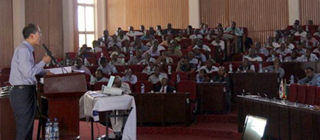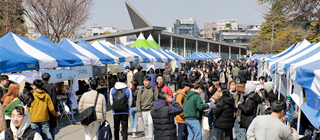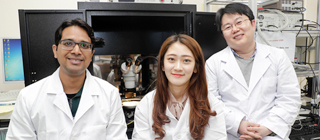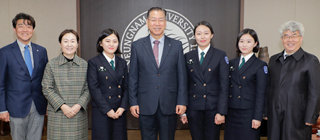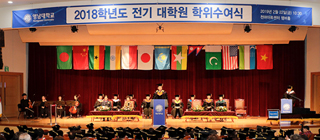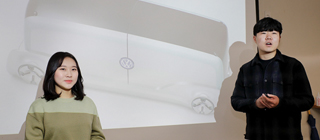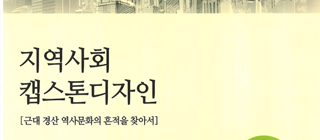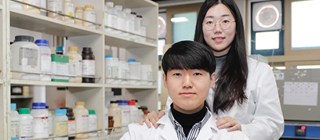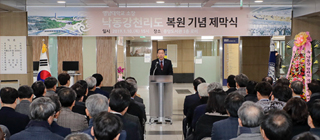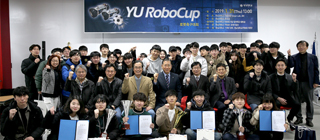-
KOICA evaluated 120 global education and training for three years and six months since 2015 ‘YU Ethiopia SNNPR Saemaul Undong local training’ selected as top case [March 5, 2019] <Ethiopia SNNPR local Saemaul development training for public employees (Feb 2016)> YU was selected as the best case for global education and training by KOICA (Korea International Cooperation Agency) for its ‘Ethiopia SNNPR Saemaul Undong policy research’ program conducted in SNNPR (Southern Nations, Nationalities and People’s Region) in Ethiopia in February 2016. KOICA conducted the ‘2018 global education and training excellent performance case contest’ for 120 global education and training programs conducted from March 2015 to August 2018 for three years and six months, and it ranked YU’s Ethiopia SNNPR Saemaul Undong local training program as the best case. On Feb 27, 2019, the ‘2019 KOICA New Global Education and Training Institute Seminar’ was held at KOICA. At this seminar, YU Professor Choi Wae-chul (Department of Saemaul and International Development) introduced the Saemaul local training case in Ethiopia in 2016 conducted by YU and received the ‘2018 KOICA Best Global Training Project Award’ plaque by KOICA President Lee Mi-gyung. At the time, Professor Choi served as the director of the YU international development cooperation center and was in charge of the Saemaul local training program in Ethiopia. <Presentation of the best 2018 KOICA global training case> Meanwhile, KOCIA’s ‘Best Global Training Project Award’ was pursued as part of a project for finding and sharing outstanding cases to improve the level of global education and training projects among ODA projects targeting developing countries by KOICA. KOICA collected cases from 10,004 people who participated in the projects including overseas offices, public agencies, training institutes, trainees, etc. in all of KOICA’s global training and education projects from March 2015 to August 2018 (3 years 6 months) and analyzed and assessed the global training project program’s suitability and effectiveness of its achievements by consigning a professional institute. There was a total of 147 applications in this evaluation and among them, 120 were evaluated. By region, 41 were in Asia-Pacific, 43 in Africa, 15 in Latin America, 6 in the Middle East and CIS regions, and 15 in other regions. The review criteria of outstanding cases that KOICA announced were performance and content. The performance sector is composed of the suitability of performance (conformity with the KOICA training project goals, conformity with the development demand of beneficiary countries, conformity with international development cooperation standards) and the effectiveness of the achievements (efficiency of the achievement process, impact of achievements, sustainability of achievements). The contents sector is comprised of concreteness (concreteness and reality of the achievement process description, clarity of the achievements and expected effects description) and logic of contents (feasibility and consistency of contents, clarity of proof). In the YU Ethiopia Southern Nations, Nationalities and People’s Region SNNPR Saemaul Undong education and training, YU prepared the educational program and dispatched faculty to Ethiopia to conduct training in Ethiopia to about 700 local public employees from February 20 to March 1 back in 2016. The public employees who attended the training gave high scores in all objective evaluation indicators such as training achievement, trainee satisfaction and application plans in the follow-up evaluations. The Ethiopia SNNPR is one of the nine provinces of Ethiopia and its population is approximately 19 million. In particular, the Ethiopia SNNPR recently elected a new governor and requested two in-depth Saemaul development training and education to YU to pursue local social development through Saemaul development. In result, two training sessions are scheduled to be offered from March of 2019. This is another reason why the YU Ethiopia SNNPR Saemaul local training and education was given positive reviews. It was judged that what the YU Saemaul education program left behind was that despite the poor financial conditions of developing countries, the will of the leader who intends to pursue social development by procuring financial resources for education through independent efforts is an important element for the success of local development, and that despite the fact that the highest leader in the provincial government changed, Saemaul development was judged to be an effective policy for overcoming poverty and to achieve local social development. Professor Choi Wae-chul (Department of Saemaul and International Development), who is also an advisor for the Ethiopia SNNPR said, “Korea received 12.77 billion dollars in aid from the international community back when it was poor. It is now time to repay the international community that helped Korea overcome its poverty in the past. In particular, Korea transformed from a country that received international aid to a country with a per-capita income of 30,000 USD, and therefore, Korea has the responsibility to share its development experience with the 146 developing countries (beneficiary countries) that still face difficulties.” Professor Choi added, “Such attitude is the way for the people who received financial resources from the international community to be used as the driving force for national development to repay the international community. Furthermore, this will not only open up paths for our future generations in the international community, but will serve as a shortcut to expand the market for industrial products of Korea.” The Saemaul Undong has been used as a policy plan by the UN’s World Food Programme (WFP) since 2011 to overcome poverty in developing countries around the world and in 2013, the Saemaul Undong was registered as a UNESCO Memory of the World. YU has worked continuously on creating the Saemaul Undong an academic science and to share it for the development of developing countries. Meanwhile, YU YU has offered Saemaul international developing sharing education programs for 85 countries as of 2019 and this year, it is scheduled to offer training for high-ranking public officials in SNNPR of Ethiopia and training for Saemaul education teachers of Myanmar and Rwanda. Furthermore, YU is receiving attention as the main university for education and research of global Saemaul studies (Saemaul development studies by providing support and counsel for the installation of the ‘Saemaul Economic Development Department’ at universities in Zambia and Cambodia.
-
The YU General Clubs Association held the ‘Club Expo’ on the 13th and 14th 80 clubs in eight divisions including academics, volunteering, sports and arts recruit new members on the streets Over 2,000 students joined clubs and are enjoying campus life [March 14, 2019] <YU 2019 Club Expo> “2019 freshmen! Join clubs and enjoy campus life~” Clubs are recruiting new members from freshmen with the start of the new semester in 2019. The YU’s 32nd Hanbit General Clubs Association (Chairman Song Min-wook) held the ‘2019 club expo’ on Cheomaro on the campus on the 13th and 14th. The central club expo is an annual event held in March and it is an evert where club members explain the features and activities of their club to freshmen to recruit them. <Dance club 'Max&Zenith' perform at the ‘2019 Club Expo’> Eighty clubs from eight divisions such as language, culture, academics, applied academics, religion, volunteer, sports and arts under the YU central clubs engaged in activities to recruit freshmen and other students to their clubs. On the 14th, the YU dance club ‘Max&Zenith’ and ‘Cheonma Cheer Team’ put on a surprise show receiving great responses from new-coming students. YU General Club Association Song Min-wook (23, Electronic Engineer, senior) said, “There are currently about 2,000 students that are active in different clubs. Clubs can make college life richer. In addition to the expo, clubs are always opened to new members.” He added, “Freshmen in 2019 can visit various clubs and join their favorite club to enjoy a fun campus life.”
-
Senior Kim So-hyun’s achievement with ‘research on electric energy storage materials’ Developed highly efficient new material that can store high electric energy High value for industrial use such as electric vehicles, military rail guns, medical defibrillators, etc. [March 13, 2019] <School of Materials Science and Engineering senior Kim So-hyun (center) who published a study as the primary author in an international journal as an undergraduate student)> An undergraduate student at YU published a study as the primary author in an international journal. A paper on her studies on electric energy storage materials by School of Materials Science and Engineering senior Kim So-hyun (21) was recently released on the online version of an international journal on electric materials <Electronic Materials Letters, impact factor (IF 2.884)>. In this research, Ms. Kim developed highly efficient new materials that can save high electric energy. This device that releases high electric energy instantaneously such as for electric vehicles and defibrillators uses a material called a high energy capacitor bank. Kim developed the material used for high energy capacitor banks through this study. Kim said, “High energy capacitor banks need materials that can instantaneously release much higher electric energy compared to batteries generally used when storing electric energy. Ceramic materials that have high genetic capacities (ability to store electricity) are affected little by the temperature or user environment compared to polymer materials that were used in the past. In addition, even if the same electric energy is stored, it can significantly lower its volume and weight.” She explained further saying, “I successfully developed new materials with very high efficiency that stores high electric energy by developing a PLZT [lead (Pb), lanthanum (La), zirconium (Zr), titanium (Ti), oxygen (O) compound] ceramic material among reinforced genetic ceramic materials.”. Professor Ryu Jung-ho, who advised Ms. Kim at the YU School of Materials Science and Engineering functional materials and element research lab, said, “Just as a lot of electric energy is needed when a stopped electric vehicle starts, it can be applied in energy storage devices of systems that supply large amount of electric energy instantaneously.” He added, “It has high industrial value as it can be used as energy sources for electric vehicles, military rail guns, and medical defibrillators.” Kim said, “I am planning to go on to graduate school through the integrated bachelor’s and master’s course. I believe that I have gained the fundamentals as an undergraduate through this research. In graduate school, I will conduct research on developing new materials that are academically and industrially useful.” She added, “I especially want to do research in ‘energy harvesting’ technologies that convert energy that not used and thrown away into electric energy.”
-
4 ROTC and 1 cadet in the third military academy and 1 cadet in the non-commissioned officer academy last year for a total of 6 cadets Achievements of operating the ‘female military incubation program’ supervised the Employment Office and ROTC Operation of systematic education program such as theories, duties, character, and physical training [March 13, 2019] <YU students selected for the 59th ROTC cadets> (From left to right – Employment Office director Lee Seung-woo, Instructor Baek Sung-hee, student Choi Yoon-young, YU President Sur Gil-soo, Kim Jung-in, Oh Ji-eun, Vice-president of academic affairs Lee Tae-jin) YU (President Sur Gil-soo) is receiving attention as a university for training female military cadets. YU helped four students become cadets for the 59th ROTC, while one cadet for the third military academy and one cadet for the non-commissioned officer academy. Thus, six female military cadets came from YU in the past year, thus making YU recognized as a cradle for female military officers. Kim Jung-in (20, Dep. of Chinese Language and Literature, junior), Oh Ji-eun (20, Dep. of History, junior), Choi Yoon-young (21, Dep. of English and English Literature, junior), and Ahn Hye-jin (21, Dep. of Special Physical Education, junior) were selected as ROTC cadets, while Lim Seul-gi (22, Dep. of Political Science & Diplomacy, junior) was selected as a cadet for the third military academy and Seo Yoo-bin (20, Dep. of Civil Engineering, junior) was selected as a non-commissioned officer cadet. The ROTC cadets will complete their school and military training simultaneously and join the military as officers after graduating. YU has shown a continuous increase of female officers since 2006. The reason why YU has been able to continuously shape female military officers is because of the female military officer fostering program offered by the university. YU has been offering systematic education programs for female students who wish to become military officers through its Employment Office and ROTC Office since 2005. YU operates educational programs that include theoretical and practical education, as well as physically fitness and character education to improve the students’ capacities to become military officers. It helps students prepare for written tests through intellectual abilities, work attitude, judgement inspections, and history education, as well as physical training such as running, push ups and sit ups. It also provides education to enhance their national view, security views and military mindsets as well as on leadership to help them prepare for interviews. In particular, the female military officer incubation program operated by YU has been making great achievements with Reserve Major Baek Sung-hee, who also graduated from YU, taking charge of instructions. Major Baek Sung-hee joined the service in 1990 and completed 20 years. After retiring, she returned to YU to share her experiences and know-how to her juniors at YU. YU President Sur Gil-soo said, “There has been a recent growth of women in the military and the competition for female cadets has also increased. Students will be able to empower themselves by finding their aptitudes early on and preparing for their career paths.” He added, “I hope that students will gain competitiveness for employment through the various customized processes offered by the university.”
-
Graduation ceremony for general graduate school held at the Cheonma Art Center at 10:30 a.m. on the 22nd 85 PhDs, 389 master’s 3,945 bachelors [Feb 22, 2019] YU (President Sur Gil-soo) held the 2018 graduate school graduation ceremony at the Cheonma Art Center Chamber Hall at 10:30 a.m. on the 22nd. Separate graduation ceremonies were held for different departments, law school, business administration, public administration, Park Chung Hee School of Policy and Saemaul, and other special graduate schools. On this day, 3,945 people received their bachelor’s degree, 389 master’s degrees, and 85 PhD’s. Among them 98 international students (42 bachelor’s, 28 master’s, 28 PhD’s) received their degrees. YU president Sur Gil-soo, YU Graduate School Dean Seo Jung-sook, Yeungnam School Foundation President Han Jae-sook, YU General Alumni Association Chairman Jung Tae-il, etc. attended the graduation ceremony to give diplomas and congratulate the graduating students. In his congratulatory address, YU President Sur Gil-soo said, “I am confident that the knowledge and capacities gained at YU will be a big driving force for the development of our nation.” He added, “Please remember that graduation is not the end, but only the start to go out to a new world. Believe in your potential and live a life of challenges.”
-
Praised for auto-driving bus food, etc. “Confident to compete with students in Seoul” <YU Department of Industrial Design’s ‘Serbus’ team took second place in the Audi Volkswagen Korea College Student Idea Contest> (clockwise from left to right: Dep. of Industrial Design Sohn Hee-bong, Shin Guk-tae, Kim Mi-hyeon, Professor Seo Hyeok-jun In a college student idea contest for young and innovative digital service (AVK – Future Mobility Challenge)’ that proposes the future of mobility and makes movement convenient, the YU ‘Serbus’ team won second place (KAIST Graduate School of Green Transportation Dean Cho Cheon-shik Award, prize 3 million won). I met with these students on the 8th at the YU College of Design and Art Room 221. There were numerous illustrations taped to the glass wall of this lecture room normally used by the Serbus (service + bus) team that configured the synthesis of buses and commercial spaces. Their efforts to come up with good ideas were could be seen here. Sohn Hee-bong (24, Dep. of Industrial Design, junior) who successfully led the team in the contest said, “I learned about this contest during a study group meeting in October of last year. About 120 teams competed and 10 teams passed the preliminaries, and a final 5 team received mentoring to make a final presentation.” He continued to explain, “We proposed to make it possible to enjoy services such as hamburgers, coffee, fitness, and cosmetic services in the self-driving bus. It is possible to separate or combine spaces to change the services offered for different time frames.” Shin Guk-tae (23, Dep. of Industrial Design, junior) said, “The process of finding a contact point considering design and technical aspects was difficult. I was focused more on design, which is my major, and so we came up with solutions by receiving mentoring in technical parts.” He added with a smile, “I no longer had to feel intimidated because I attend a college outside of Seoul and became confident that I could compete with students in Seoul.” Professor Seo Hyeok-jun (34, Department of Industrial Design) explained the birth of the Serbus team saying, “It takes more than just one cool image. Scores are given for the thought put into the idea and how it is developed through the final selection process, and that is why many people say the AVK contest is harder than others.” He added, “Even though the students live in a smaller region, they should participate in larger contests such as international contests to gain insight on changes in the future vehicle industry and the importance of transportation services, while also learning which brands and companies are making what kind of preparations, and also broaden their horizons.” This contest began in December of last year by Audi-Volkswagen targeting Korean college students. The five teams selected for the finals are given opportunities to receive mentor programs with automobile experts and relevant scholars. The first-place team is given a cash prize of 10 million won, an opportunity to visit the head office in Germany, and bonus points when applying to internship programs of Audi-Volkswagen Korea.
-
Department of Sociology offers major in ‘Community Innovation Capstone Design’ Showing potential for ‘college-community linked education’ Presented blueprints for ‘humanities and sociology college education’ outside of industry-academic cooperation focusing on engineering [February 28, 2019] Regular classes operated by YU (President Sur Gil-soo) are receiving attention as a new type of college education. This is the ‘Community Innovation Capstone Design’ class that the Dep. of Sociology began offering as a major. Students that take this class do not sit in a fixed lecture room, but instead investigates and interacts with nearby communities such as in Daegu or Gyeongsan for one semester to find problems on their own and set up projects to participate in projects such as urban regeneration, town-making, creating local cultures, etc. In the second semester of the 2018 school year, 18 students of the Dep. of Sociology participated in the class under the theme ‘Finding Traces of Modern Historical Culture of Gyeongsan’. They split up into four teams and engaged in the project with local residents of the old downtown area of Gyeongsan (today’s Seosang-dong, Gyeongsan) to reinvestigate Seosang-dong Village and the old streams and sites, finding the capital of Gyeongsan, reinvestigating the cobalt mines, and reinvestigating modern industries. They met with local residents to hold interviews and they examined materials to search for local activation plans and to produce pamphlets to share lesser-known historical facts such as the cobalt mine massacre. Jung Young Wook (23, Department of Sociology, junior) who participated in the second semester class of 2018 said, “It was a new experience outside of the classroom. I was able to think about various things by integrating the theories and critical views that we learned in class in our community. There were many trials and errors while working on the project, but it was a valuable experience that made it possible to improve problem-solving skills.” <Pamphlet of the Gyeongsan cobalt mine massacre produced by students who took the ‘Community Innovation Capstone Design’ class> YU Department of Sociology Professor Jung Yong-gyo who oversaw last year’s ‘Community Innovation Capstone Design’ class explained, “This class showed the possibility of utilizing the specialized human resources of the university and the creativity of the students for energizing the region and the success of urban regeneration projects through integration with economic and social circumstances. This goes beyond the many engineering-oriented industry-academic cooperation projects and acts a new education model of college-community linked education in the humanities and sociology.” He added, “It will not only provide the cornerstone for community development, but also enhance student understanding on the community and contribute in improving capacities as local experts.” The ‘Community Innovation Capstone Design’ course is being carried out with the support of the YU (LINC+) project team and YU published a book containing the results of the classes of the second semester of the 2018 academic year titled ‘Community Capstone Design - Finding Traces of Modern Historical Culture of Gyeongsan’ (Hansol Publication Company, book cover on top left).
-
School of Chemistry and Biochemistry senior Heo Joon-nyeong (principal author) and Doh Jung-yeon (corresponding author) in the Graduate School of Chemistry PhD program Students completed the entire thesis drafting process without assistance from an advisor Research paper published in the latest issue of an international journal in the industrial chemistry sector [February 13, 2019] The joint research of an undergraduate and graduate school student of the YU School of Chemistry and Biochemistry came to fruition. This research achievement was especially more significant because students completed the entire process of drafting a thesis from finding a problem, experimenting and coming up with conclusions without the assistance of an advising professor. School of Chemistry and Biochemistry senior Heo Joon-nyeong (24, bottom on photo) was the principal author and Doh Jeong-yeon (27, top on photo) currently working on her doctorates at the Graduate School of Chemistry was the corresponding author for this study. This paper was pre-released on the online version of the international academic journal in industrial chemistry <Journal of Industrial and Engineering Chemistry, impact factor (IF) 4.84> and it is scheduled to be carried in the journal to be released on February 25. The study they presented was on the development of dye waste water treatment photocatalysts that are cheap, yet highly efficient. In this study, they used rice bran as carbon resources to recycle wastes, while lowering catalyst manufacturing costs. The principal author Heo Joon-nyeong said, “It takes less than 60 minutes to completely remove 100ppm of methyl orange by using rice brans. It exhibits better photo-activation than the better-known titania photocatalyst.” He added, “We presented a method to supply cheap photocatalysts that are excellent for organic decomposition in mass quantities.” Ms. Doh Jeong-yeon said, “By designing the catalyst to collect catalysts after reaction to be reused by utilizing the magnetic properties of iron, not only is it economical, but it also collects the magnetic catalysis using a magnet, therefore making it eco-friendly that can prevent secondary environmental pollution resulting from the catalysts after reaction. Moreover, it uses rice bran as carbon resources thus increasing the recycling of wastes, giving it triple effects and making it very useful both academically and industrially.” The research capacities of the YU School of Chemistry and Biochemistry is famous for both undergraduate and graduate schools. Students participate in research with professors and graduate school students from their undergraduate years and has thus achieved outstanding research results such as continuously presenting SCI papers from undergraduate school years. Mr. Heo who will graduate on February 22 said, “I will go on to graduate school and conduct research on developing heat catalysts that have high value for industrial use,” and added, “I would like to contribute in Korea’s renewable energy industry.”
-
‘24m masterpiece landscape painting with Indian ink’ created by the top painter, poet and calligrapher in the 1970s Painter Min Gyeong-gap passed away recently leaving this as the only piece worked on by three masters Recently restored and reproduced after 48 years since being exhibited at YU... Samil Spinning Co. Chairman Noh Hee-chan paid for entire cost [January 11, 2019] [<Nakdonggang-Cheollido> (original) put on display at the YU Central Library Reading Room 2] <Nakdonggang-Cheollido>, a masterpiece by Yusan Min Gyeong-gap (1933-2018), a master of traditional Korean painting, will once again see the world. <Nakdonggang-Cheollido> is a massive Indian ink landscape painting with a length of 2,360cm and width of 105cm and is currently possessed by YU. It contains the 510km long Nakdonggang (Riv.) and its surrounding scenery from the source of Nakdonggang to the Nahmhae estuary in a total of nine paintings. YU possessed this piece since 1970 and it recently completed restorations and reproductions. This process took a whole six months. The restored original was put on display at the YU Central Library, while the replicas were hung at the YU Cheonma Art Center (Gyeongsan, Gyeongbuk) and the YU Medical Center Respiratory Center (Daemyeong-dong, Daegu). In particular, this painting was a collaboration of the most famous painter, poet and calligrapher at the time. The painting was completed by Min Gyeong-gap, and the ‘Nakdonggang’ poem made by Nosan Lee Eun-sang (1903-1982) was written at the brush of calligrapher Iljung Kim Chung-hyeon (1921-2006). Poet Lee Eun-sang is Korea’s most noted sijo poet who wrote Gagopa, Dongmu Saenggak, and Bomcheonyeo. Calligrapher Kim Chung-hyeon left behind his works in the April 19 Memorial Tower and Declaration of Independence and has been assessed to have played a leading role in spreading calligraphy in Hangul. With the death of Min Gyeong-gap on December 30 of last year, <Nakdonggang-Cheollido> became the only piece that was collaborated on by these three masters of arts. [<Nakdonggang-Cheollido> (replica) on display at the Cheonma Art Center lobby] Art critic Shin Hang-seop said, “It is very rare to see a masterpiece going beyond a single page in Indian ink landscape paintings. The ‘Gangsan-Mujindo’ by the famous Kim Hong-do and Lee In-mun in the late Joseon Dynasty is evaluated as an unparalleled masterpiece spanning across 8.6 meters. Since then, there were no Indian ink landscape paintings that were even comparable to it.” He went on saying, “The <Nakdonggang-Cheollido> was an incident that rewrote the history of Indian ink landscape painting in Korea. It not only had an overwhelming scale, but it is also surprising as it depicts real scenery and not a conceptual world. It also has an unconventional structure that shakes the very roots of concepts of existing landscape paintings as it follows the 390km long Nakdonggang and gives a panoramic view of its surrounding scenery. The <Nakdonggang-Cheollido> contains the ambitious vision and hopes of YU back in the 1970s when it was aiming to build a global campus. This masterpiece was first unveiled during an exhibit held at the YU Daemyeong-dong Campus Library in April 1970. In August 1976, it was moved to the west wing of Reading Room 3 of the Central Library of Gyeongsan Campus, which was a main symbol of YU. In February 2005, upon the completion of the renovation of the Central Library, it was moved to its current location at the northern part of Reading Room 2. [<Nakdonggang-Cheollido displayed at the Central Library Reading Room 3 in 1981] The existence of this masterpiece was not well known until now. There were even some within YU that did not know about this. However, in November 2017, YU President Sur Gil-soo noticed the artistic value and meaning of the <Nakdonggang-Cheollido> and so it was restored and preserved under his lead. YU President Sur Gil-soo said, “I believe that this work created through the collaboration of the greatest artists of the time will be a cultural asset for not only our university, but our entire country. We restored and are preserving the original and we also made replicas and placed them in areas where many people visit so that many members of our school as well as visitors can enjoy and appreciate the piece.” Because it is an epic masterpiece stretching 24 meters long, it was difficult not only in the restoration work, but also finding the right spot to put it on display. It cost quite a lot too. YU alumni from the Department of Chemical Engineering class of ‘63 and current chairperson of Samil Spinning Co. Noh Hee-chan (right on photo), who has always been interested in the development of the university, happily stepped up. Once Chairman Noh announced that he would pay the entire 100 million won needed for restoration and reproduction, the restoration project began sailing smoothly. Students majoring in art preservation and restoration (School of Fine Arts) of YU also contributed to the restoration work. In March of 2018, the <Nakdonggang Cheollido> restoration/reproduction project steering committee was organized, and the first course of action was meeting with the painter, Min Gyeong-gap in order to listen to stories behind the production of the work before conducting restoration work. Mr. Min, in his last interview in March of last year before his death, said, “The idea for this painting was made by the second YU president and former Minister of Culture and Education Lee Seon-geun. I went on a helicopter to look around Nakdonggang. Together with photographer Sung Nak-in, who was a professor at Hongik University, we traveled taking photos and making sketches for two weeks. It was such a big project that it took six months to complete. After completing the work, all I did for an entire week was sleep.” On behalf of the late Mr. Min, his oldest song Min Ji-hong attended the unveiling ceremony in commemoration of the restoration on the 10th. Min Ji-hong said, “My father received an invitation for the unveiling ceremony before passing away last December. Despite being very ill, he said that he would attend the ceremony even if he had to do so on a wheelchair, and he showed a lot of affection for <Nakdonggang Cheollido>. I would like to thank YU on behalf of my father for letting more people see my father’s work. YU recently held an unveiling ceremony to commemorate the restoration of <Nakdonggang Cheollido> in the lobby of the Central Library at 3 p.m. on the 10th. In attendance were Chairman Noh Hee-chan who sponsored this restoration project, Yeungnam School Foundation Chairwoman Han Jae-sook and Executive Director Kim Jin-sam, YU President Sur Gil-soo, former YU President Lee Hyo-soo, YU General Alumni Association Chairman Jung Tae-il, Korea Kolmar Chairman Yoon Dong-han, Daegu Foundation for Culture President Park Young-seok, eldest son of the late Min Gyeong-gap – Min Ji-hong, art critic Shin Hang-seop, Restoration and Reproduction Project Steering Committee Chairman Park Jong-moo, Museum Curator Jung In-sung, and YU School of Fine Arts Lim Nam-soo and College of Liberal Arts Professor Jung Doo-hee (major in art preservation and restoration) who worked on the actual restoration.
-
Joined by over 70 students from the College of Mechanical and IT Engineering and PRIME project teams... School of Mechanical Engineering ‘botnaldu’ team victorious Produced and operated ‘balancing robot’ that integrated mechanical, electronic, electric, SW and wireless communication technologies ‘Integrated knowledge and technologies from various majors to improve problem-solving capacities’ [February 1, 2019] YU (President Sur Gil-soo) held the 2nd YU RoboCup, which is a robot football tournament. This contest was hosted by the YU College of Mechanical and IT Engineering and the PRIME Project Team and it was held at the YU Automobile Hall lobby at 1 p.m. on January 31 with the PRIME Robot Project Team as the sponsor. Approximately 70 students in schools (departments) working with the PRIME project participated. Following the debut year last, the second ‘YU RoboCup’ held this year is a robot football contest using self-made balancing robots. Students participate in the contest by producing their own balancing robot by integrating mechanical, electronic, electric, SW, and wireless communication technologies. Teams were made up of two students for one robot and they control their self-built robots using smartphone applications, RC controllers, etc. in a tournament held in a designated stage. YU President Sur Gil-soo said, “The importance of robot engineering has been rising in Korea and this is shown with AI robot football tournaments being held. Students will be able to enhance their understanding on technological convergence and improve their problem-solving skills by building and operating their own balancing robot by combining what they learn from their major and IT technologies.” He added, “We will pursue various integration and convergence education programs to help YU students become creative convergence talents that will lead the fourth industrial revolution.” The ‘botnaldu’ team (photo on right) comprised of School of Mechanical Engineering Cho Yong-woon (sophomore) and Lee Tae-hoon (sophomore, ‘Mechanical Systems’ major) won the tournament. ‘EESOFT’ team comprised of Department of Electronic Engineering Kim Ga-yeon (junior) and Lee Seung-jae (sophomore) came in second place. Meanwhile, as part of the Ministry of Education’s ‘PRogram for Industrial needs – Matched Education (PRIME) project’, YU established the College of Mechanical and IT Engineering in 2017. YU split the electric, electronic, computer, information communication and mechanical engineering majors within its former College of Engineering to establish the College of Mechanical and IT Engineering, while newly establishing the Department of Robotics and Intelligent Machine Engineering and the Department of Automotive Engineering. YU is focusing on developing its mechanical, electrical, electronic and computer sectors, which YU is traditionally known to be especially strong in, together with smart robots and future automobiles, which are future new growth engine fields.
